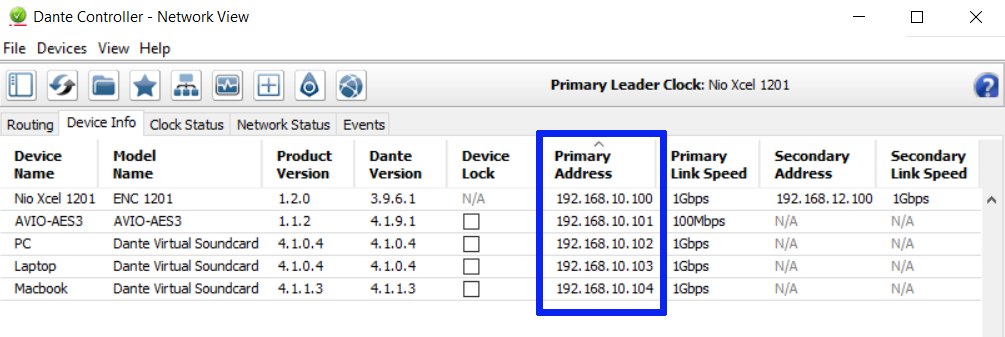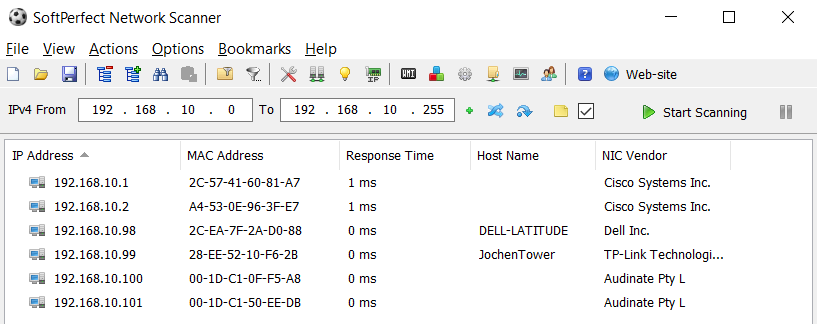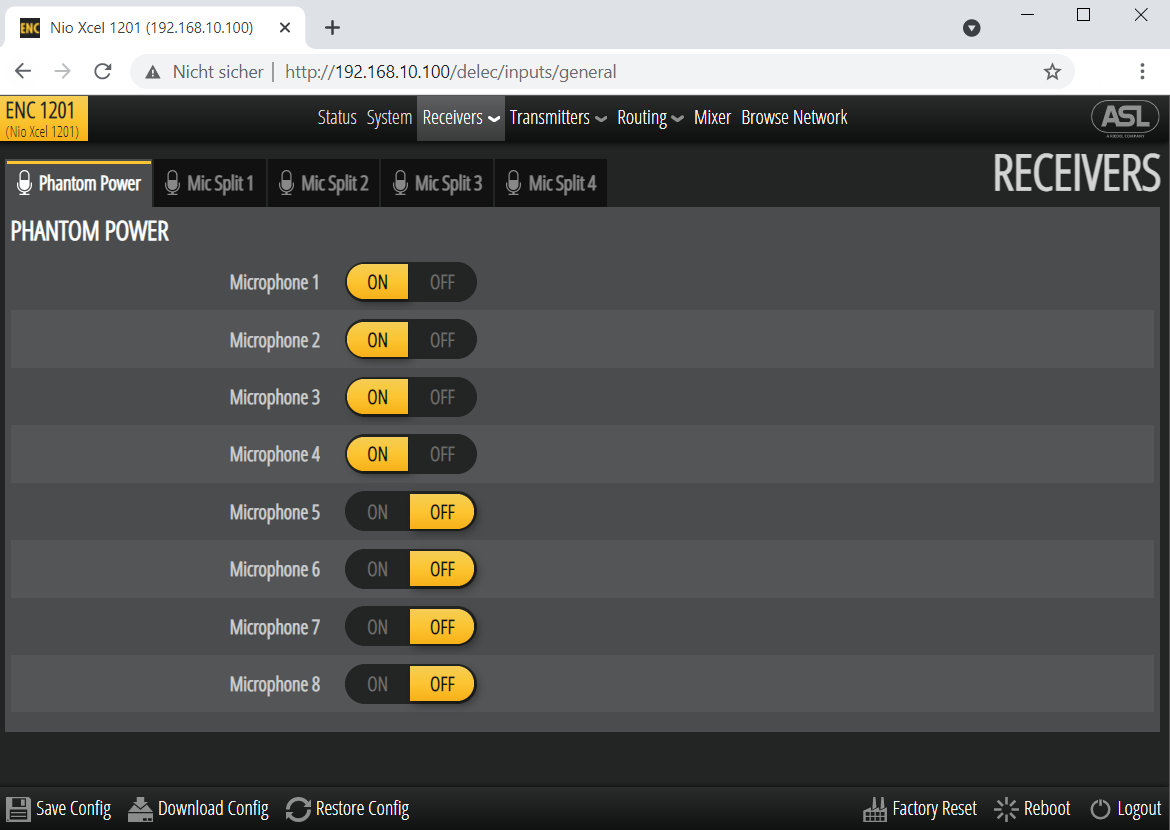6 Advantages of Static IP Addresses
One of the first steps in setting up a Dante network is to assign IP addresses to each device, or to choose the “automatic mode”.
A few preliminary considerations are fundamentally necessary, because every device in a network must be in the same address range so that communication with each other works. And secondly, each address can only be assigned once.
If you've never looked at IP addresses before, the automatic mode is certainly very tempting. And if there are only a few Dante devices, only a single network, presumably everything on one switch, then nothing speaks against it. Because: it works, without much prior knowledge and long configuration settings!
In the case of larger audio systems, I still see some advantages in using static IP addresses. So that you can follow my argument, maybe two sentences briefly about the automatic mode.
The Automatic Mode
If a device is not assigned a fixed IP address, it will first try to have an IP address assigned by a DHCP server. We can see this on our smartphones every day when we dial into someone else's WLAN. Within seconds we are automatically assigned an IP address including subnet mask and gateway.
If no DHCP server responds to the request, our device looks for a random address in the Link-Local range (169.254.x.x), also known as the Zero-Conf range. It checks whether any other device can already be reached at this address, and if not, the device assigns this address to itself.
255 different numbers can be used at each of the two x positions in 169.254.x.x. The entire link-local area therefore comprises around 255 * 255, i.e. over 65,000 addresses.
Advantages of Static IP Addresses
If you don't want to leave anything to chance, you can manually configure the IP address for each device. And compared to the Auto-IP process described, I see a few advantages here with larger Dante systems:
1) Sortable device list in Dante controller
Yes, it sounds so banal and yet it can make life a lot easier! The addresses that the network participants assign themselves are randomly distributed in the range 169.254.x.x. I.e. the order is completely arbitrary and sorting does not add any value.
If you assign the addresses manually, you can determine the order yourself. And if you use the addresses consecutively, even your intern will notice without much background knowledge if a number is missing somewhere in the device list.
Continuous numbering can also be created using the device name, for example Amp 01, Amp 02, .. Amp 10. But there are usually many different devices in a Dante network, each of which should be given a name that is as unique as possible according to their function. I think using the IP address to sort things according to your own requirements is the more charming approach.
2) Network IP scanner
The Dante Controller already offers a good overview of the Dante devices. But on the one hand there are sometimes also non-Dante devices such as control PCs and switches in the network, on the other hand some Dante devices have a second IP address for their control.
With the help of a network IP scanner, an overview of the address range used can be obtained very quickly. All devices that are currently using an address appear there, Dante and non-Dante devices.
Clever tools automatically look up the manufacturer based on the MAC address so that you can see at a glance whether it is a Dante chip from Audinate, a switch from Cisco, or a small USB network adapter* from TP-Link that I use on my PC for Dante. This is not only useful for the documentation to record the current status, but also to find out whether devices are missing or whether third-party devices appear that actually do not belong there. And the name usually appears on Windows PCs. The whole scan takes just one minute for the usual network size (with subnet mask 255.255.255.0, i.e. 255 hosts).
Now, of course, a scan is also possible for the link-local range. Unfortunately, this range with its 65,000 hosts is much larger. If we extrapolate the 1 minute per 255 hosts to 65,000 hosts, the scan would take over 4 hours. Performing a quick IP scan unfortunately fails in connection with Auto-IP based networks.
3) Memorable IP addresses for web interface
If you already have a microphone preamp with Dante, you will know the situation: to set the preamplification and phantom power you have to open the web UI in a web browser. Hardware control elements on the devices are becoming increasingly rare.
Even EQs and levels of amplifiers can often be easily changed via a browser without having to install special software.
If I ask you to remember the two IP addresses 192.168.10.10 and 169.254.138.216, which ones will you be able to tell me in a minute? ;)
With the first, it is up to you to assign a subnet and the last digit for those devices that you use frequently. And since all Dante devices are in one subnet, all you really need to remember is the last digit. Unfortunately, you have no control over link-local addresses, and the addresses are accordingly difficult to remember.
If you always work on the same PC, you can bookmark the most important devices in your browser. But not infrequently you have to make a small change on stage with some random laptop or iPad. If you then know the address by heart, you will arrive at your destination without frustration.
4) Dante Controller only allows one IP address
If you came up with the idea at point 3) that Dante and control IP addresses should be separated, i.e. to leave Dante in the automatic link-local range and the control addresses in a 192.168.x.x. range to be assigned: it's nice that you think along - the idea is not bad!
Unfortunately, there are two small hurdles that make this impractical. Some Dante devices only use a single address for the Dante and Web UI parts. A clear separation is therefore not always possible. At most the switches could be clearly set in the 192.168.x.x. range.
The bigger problem is the Dante controller. Anyone who has ever tried to assign several IP addresses to their PC at the same time (e.g. 192.168.x.x and a self-assigned 169.254.x.x) will know this error message:
And this error message unfortunately means that the Dante Controller does not display anything afterwards, neither the devices in one nor in the other network range.
It would be nice to be able to choose one of the possible IP addresses. But - as of today - the only way to use the Dante Controller is that you have to change the IP address of your computer every time you want to work in the other address range. Not a pleasant solution as I know from my own experience. If it really has to be with two address ranges in one VLAN, a small USB network adapter* for 13 USD helps (again). This then gives you two separate network ports and the Dante Controller is happy.
To counteract the whole chaos, my recommendation: either leave all devices in the automatic link-local range, or assign a static IP address to all devices.
5) Tamper-proof against accidental DHCP server
The search for a DHCP server does not end after the boot process for devices in Auto-IP mode. Even if a Dante network works stably in the link-local address range for a year, as soon as a DHCP server is connected to the network, it will assign new IP addresses to all devices.
The audio transmission will probably continue to play with new IP addresses and nobody will notice the process. And even if the DHCP server is disconnected from the network or deactivated after a minute, the devices keep their new address and everything continues. Only the bookmarks in your browser for the web interface of your microphone preamps will no longer work.
However, the whole thing becomes uncomfortable as soon as you add a new device that again assigns itself an address in the link-local range due to the missing DHCP server. This device - maybe your mobile laptop or a mobile Dante interface - will then no longer be able to connect to the other devices. The same applies if some devices have continuous power and some devices are switched off overnight.
So the surprise comes much later. And it is correspondingly difficult to even remember what might have triggered the whole thing and when.
Most switches these days have a built-in DHCP server. Especially when you connect other sound colleagues with their equipment to your own system during a guest performance, there is a risk that they may have needed a DHCP server from their previous job. Even if you notice this immediately and switch it off, after 5 seconds the house Dante network is already set to the address range of the external DHCP server.
The only way out in such a situation is - after deactivating the DHCP server - restarting all devices.
Admittedly, such a scenario rarely occurs. But there is a chance, especially when more and more guest crews or recording teams and OB vans are equipped with Dante interfaces. With static IP addresses, there is no such risk.
6) Failsafe
Now there is still one way open to use most of the advantages of static, i.e. sorted and clear, IP addresses: a dedicated DHCP server for the Dante network. And yes, then you would only have addresses in the 192.168.x.x range, and these would also be nicely connected, because the DHCP server usually assigns the addresses in ascending order. If you do not configure anything further, the addresses are assigned in the order in which the devices are switched on. Not always, for example, you get all amplifiers listed nicely one after the other. And even if you set the validity of the addresses to several days, there is still the risk that the addresses will change among each other and, for example, the bookmarks in the browser will no longer work. Everything somehow cumbersome.
However, I see the main argument against the use of a DHCP server in the reliability. At some point every device has a bad day and does not work as intended. If this stops your Dante system from working properly, it is a serious operational problem.
For permanently installed devices such as a mixer, an audio DSP or the amplifiers, I would always assign a fixed IP address. Using a DHCP server may sound comfortable, but for fixed devices it wouldn't be worth the risk to me. You only have to set the addresses once every 5 years and then you can be sure that at least these fixed devices will always work.
I only see the use of a DHCP server in the Dante network as an enrichment for mobile devices or guests. Just like with a smartphone, you just have to plug in and you can start immediately without the annoying question of a free IP address. And if the DHCP server actually fails and the device does not get an automatic IP when booting, you can quickly assign a fixed IP for one device.
A small note: if you have never assigned static addresses to Dante devices, as soon as you change the address and restart your device, you will initially no longer have a connection from your Dante Controller with this device. Only when you assign your PC an IP in the corresponding address range will you have access again and, if necessary, can return to Auto-IP mode.
So much for my experiences and recommendations on the topic of static vs automatic IP addresses! I hope you could give yourself a few good arguments why the assignment of static IP addresses can be worthwhile!
*Affiliate link
More articles on Dante:




